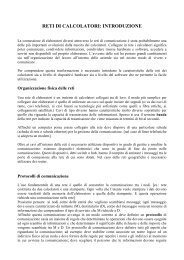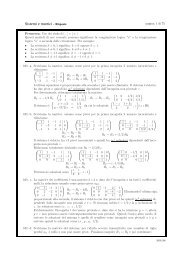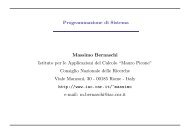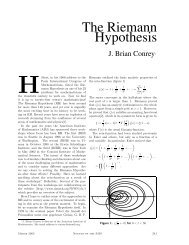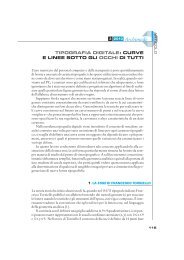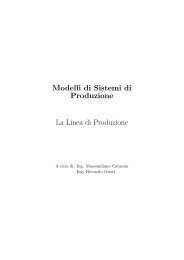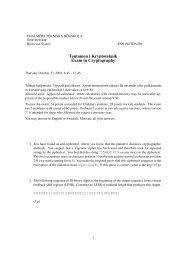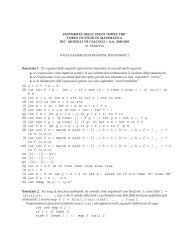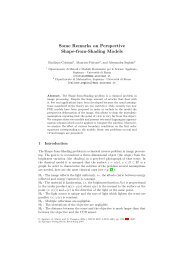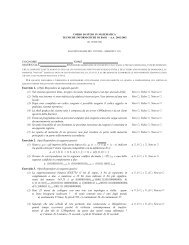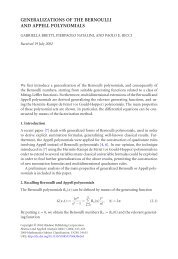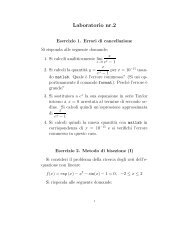Mass diffusion through two-layer porous media: an ... - ResearchGate
Mass diffusion through two-layer porous media: an ... - ResearchGate
Mass diffusion through two-layer porous media: an ... - ResearchGate
You also want an ePaper? Increase the reach of your titles
YUMPU automatically turns print PDFs into web optimized ePapers that Google loves.
International Journal of Heat <strong>an</strong>d <strong>Mass</strong> Tr<strong>an</strong>sfer 50 (2007) 3658–3669www.elsevier.com/locate/ijhmt<strong>Mass</strong> <strong>diffusion</strong> <strong>through</strong> <strong>two</strong>-<strong>layer</strong> <strong>porous</strong> <strong>media</strong>:<strong>an</strong> application to the drug-eluting stentGiuseppe Pontrelli a, *, Filippo de Monte ba Istituto per le Applicazioni del Calcolo – CNR, Viale del Policlinico, 137 – 00161 Roma, Italyb Dipartimento di Ingegneria Mecc<strong>an</strong>ica, Energetica e Gestionale, University of L’Aquila, Località Monteluco, 67040 Roio Poggio (AQ), ItalyReceived 2 June 2006Available online 2 J<strong>an</strong>uary 2007AbstractA mathematical model for the <strong>diffusion</strong>–tr<strong>an</strong>sport of a subst<strong>an</strong>ce between <strong>two</strong> <strong>porous</strong> homogeneous <strong>media</strong> of different properties <strong>an</strong>ddimensions is presented. A strong <strong>an</strong>alogy with the one-dimensional tr<strong>an</strong>sient heat conduction process across <strong>two</strong>-<strong>layer</strong>ed slabs is shown<strong>an</strong>d a similar methodology of solution is proposed. Separation of variables leads to a Sturm–Liouville problem with discontinuous coefficients<strong>an</strong>d <strong>an</strong> exact <strong>an</strong>alytical solution is given in the form of <strong>an</strong> infinite series exp<strong>an</strong>sion. The model points out the role of four nondimensionalparameters which control the <strong>diffusion</strong> mech<strong>an</strong>ism across the <strong>two</strong> <strong>porous</strong> <strong>layer</strong>s. The drug-eluting stent constitutes the mainapplication of the present model. Drug concentration profiles at various times are given <strong>an</strong>d <strong>an</strong>alyzed. Also, qualitative considerations<strong>an</strong>d a qu<strong>an</strong>titative description to evaluate feasibility of new drug delivery strategies are provided, <strong>an</strong>d some indicators, such as the emptyingtime, useful to optimize the drug-eluting stent design are discussed.Ó 2006 Elsevier Ltd. All rights reserved.Keywords: <strong>Mass</strong> <strong>diffusion</strong>; Multi-<strong>layer</strong>ed <strong>porous</strong> <strong>media</strong>; Advection–<strong>diffusion</strong> equation; Sturm–Liouville problem; Drug delivery; Pharmacokinetics1. IntroductionIn last years, polymeric gels are widely used as drug carriersdevices in m<strong>an</strong>y biotechnological applications, such astissue engineering [1]. A matrix of gel is filled with a specificdrug which is subsequently released into the living tissue.To have a desired therapeutic effect, the concentration ofthe drug in the tissue should lie within a given r<strong>an</strong>ge. Ifbelow that, the therapy results ineffective. On the otherh<strong>an</strong>d, if the concentration is above a threshold value, thedrug c<strong>an</strong> produce a toxic effect [2].A recent clinical application of such a technology are thedrug-eluting stents: these are complex medical devicesinserted in the arterial wall aimed to widen the lumen of stenosedarteries, to prevent occlusion, <strong>an</strong>d to restore the* Corresponding author. Tel.: +39 6 884 70251; fax: +39 6 440 4306.E-mail addresses: pontrelli@iac.rm.cnr.it (G. Pontrelli), demonte@ing.univaq.it (F. de Monte).blood flow perfusion to the downstream tissues [2–4](Fig. 1). Drug-eluting stents combine the mech<strong>an</strong>ical supportwith local drug delivery to the arterial tissue to fightearly restenosis caused by proliferation of smooth musclecells. To this aim, a polymeric matrix (gel) is added to themetallic struts <strong>an</strong>d loaded with a drug which is released afterimpl<strong>an</strong>tation. The stent struts c<strong>an</strong> be uniformly covered bythe polymer (coated stent) or it c<strong>an</strong> contain honeycombedstrut elements with <strong>an</strong> inlaid polymer (stent with drug reservoirs)(Fig. 2) [5]. It is recognized that the time <strong>an</strong>d rate ofthe drug release is crucial for the therapy. This process isinfluenced by m<strong>an</strong>y factors, such as properties of the drug(hydrophily), coating (structure <strong>an</strong>d material parameters)as well as the tr<strong>an</strong>sport characteristics of the arterial wall.Although intravascular stents are designed to operate in staticregimes, they act under complex stress conditions, varyingin time <strong>an</strong>d it is difficult to forecast their perform<strong>an</strong>ce<strong>an</strong>d efficiency over long times. Mathematical models predictingthe dynamics of solute concentration <strong>an</strong>d mass flux0017-9310/$ - see front matter Ó 2006 Elsevier Ltd. All rights reserved.doi:10.1016/j.ijheatmasstr<strong>an</strong>sfer.2006.11.003
G. Pontrelli, F. de Monte / International Journal of Heat <strong>an</strong>d <strong>Mass</strong> Tr<strong>an</strong>sfer 50 (2007) 3658–3669 3659Nomenclaturec imass volume-averaged concentration in the ith<strong>layer</strong>c 0 i fluid-phase concentration in the ith <strong>layer</strong>D i drug diffusive coefficient in the ith <strong>layer</strong>J mass flux at the interface x =0(Fig. 3)k partition coefficientL thickness ratio, L 1L 2.L i thickness of the ith <strong>layer</strong>M i dimensionless mass per unit of area in the ith<strong>layer</strong>P membr<strong>an</strong>e permeability coefficientS concentration jump at the interface x =0(Fig. 3)t timet ExX iemptying time of drugspace coordinateeigenfunction of the ith <strong>layer</strong>Greek symbolsc diffusivity ratio, D 1D 2 medium porosityk i eigenvalue of the ith <strong>layer</strong>r material ratio, k 1 1k 2 2/ nondimensional permeability,Subscripts1 first <strong>layer</strong> (coating)2 second <strong>layer</strong> (wall)PL 2D 2 k 2 2Fig. 1. Sketch of a stented artery.are of interest for biomedical engineers <strong>an</strong>d clinici<strong>an</strong>s, asthey offer a simple tool for optimizing the drug deliverydesign <strong>an</strong>d technology.A number of recent studies has been devoted to the masstr<strong>an</strong>sfer process in the arterial wall, modelled as a multi<strong>layer</strong>edmedium, coupled with the tr<strong>an</strong>sport in the lumen[6,7]. Some work has been done to correlate the number<strong>an</strong>d the location of the metallic net structure of a stent withthe extension of the perfused area [8]. Other mathematicalmodels have been developed to predict the release of a subst<strong>an</strong>cein a tissue <strong>an</strong>d the influence of the physical propertiesof the drug. However, computational difficulties incoupling different geometrical scales are reported [5,9].The present paper provides a fundamental study of thetr<strong>an</strong>sient mass elution between <strong>two</strong> homogeneous <strong>porous</strong><strong>media</strong> having different thickness <strong>an</strong>d material properties.The treatment is quite general <strong>an</strong>d c<strong>an</strong> be applied to severalmass tr<strong>an</strong>sfer <strong>diffusion</strong> dominated problems in compositematerials. The main application is the drug-eluting stent,where the whole drug is initially in a polymeric matrix coatingthe metallic structure <strong>an</strong>d is subsequently released intothe arterial wall. Being interested in the pharmacokineticsFig. 2. Section of a stented artery with the struts (in black) embedded intothe wall (courtesy of P. Zunino).only, <strong>an</strong>y structural <strong>an</strong>alysis as well as all mech<strong>an</strong>icaleffects of the stent are neglected. The chemistry <strong>an</strong>d thebinding of the drug to the tissue are beyond the scope ofthe present work <strong>an</strong>d will not be considered here. An outlineof the paper is now given.Section 2 presents the time–space <strong>diffusion</strong>–tr<strong>an</strong>sportequation for the dynamics of a subst<strong>an</strong>ce across a double<strong>layer</strong> structured material in the general case. Due to a prevalentflux direction, the problem is written in one dimensionalcase in terms of nondimensional variables. Thisresults in a coupled system of partial differential equationsin <strong>two</strong> domains with <strong>an</strong> interface condition. Despite thesurprising <strong>an</strong>alogy between mass tr<strong>an</strong>sfer <strong>an</strong>d heat conductionproblems, solutions of identical form are admittedprovided that not only the differential equations, but alsothe initial <strong>an</strong>d boundary conditions match [10]. In thecurrent case, however, the boundary conditions at the
3660 G. Pontrelli, F. de Monte / International Journal of Heat <strong>an</strong>d <strong>Mass</strong> Tr<strong>an</strong>sfer 50 (2007) 3658–3669interface do not have a counterpart in the heat <strong>diffusion</strong>problem. Differently that in the case of <strong>two</strong>-<strong>layer</strong> heat conduction,the mass flux is continuous, but a concentrationjump may occur at the interface. This follows from theequilibrium conditions with regard to mass tr<strong>an</strong>sfer (equalityof the chemical potential of each component in eachphase, see [11, chapter XI]). As a consequence, the solutionto the tr<strong>an</strong>sient <strong>two</strong>-<strong>layer</strong> heat conduction problem proposedin [16] c<strong>an</strong>not entirely be tr<strong>an</strong>sferred to the <strong>an</strong>alogousmass <strong>diffusion</strong> process of interest here. However, thesame theoretical procedure based on separation of variablesfor solving the differential problem may be reformulated,as shown in Section 3. Thus the correspondentSturm–Liouville problem is <strong>an</strong>alyzed <strong>an</strong>d the correspondenteigenvalue equation is solved. Finally, the concentrationsolution is expressed in the form of a Fourier series(Section 3).Compared to a fully numerical method, the <strong>an</strong>alyticalapproach provides a greater insight into the physical senseof the drug delivery process. As a matter of fact, the presentone-dimensional model is shown to catch most of therelev<strong>an</strong>t aspects of the drug dynamics. By showing relationshipsamong the relev<strong>an</strong>t variables <strong>an</strong>d material parameters,it c<strong>an</strong> be used to identify simple indexes orclinical indicators of biomech<strong>an</strong>ical signific<strong>an</strong>ce. Moreoverthe methodology c<strong>an</strong> be easily extended to a multi-<strong>layer</strong>edcoating <strong>an</strong>d wall structure. The model enables the effect ofimport<strong>an</strong>t factors such as drug diffusivity, coating thickness,<strong>an</strong>d membr<strong>an</strong>e permeability to be <strong>an</strong>alyzed. Tunedin optimal way, they c<strong>an</strong> be used to design novel releasemech<strong>an</strong>isms, as well as to improve drug delivery protocolsused in therapy <strong>an</strong>d diagnostics.2. Formulation of the problemA drug-eluting stent (DES) is a metallic prosthesis(strut) impl<strong>an</strong>ted into the arterial wall <strong>an</strong>d coated with athin <strong>layer</strong> of biocompatible polymeric gel that encapsulatesa therapeutic drug (coating). Such a drug, released in a controlledm<strong>an</strong>ner <strong>through</strong> a permeable membr<strong>an</strong>e, is aimed athealing the vascular tissues or at preventing a possiblerestenosis by virtue of its <strong>an</strong>ti-proliferative action againstsmooth muscle cells. In the present work we are interestedin the mech<strong>an</strong>ism of drug elution into the arterial tissue. Asa matter of fact <strong>an</strong>y other effects, such as the drug metabolismin the living tissue <strong>an</strong>d a possible decompositionof the polymeric matrix, are neglected.Let us consider a stent coated by a thin <strong>layer</strong> (of thicknessL 1 ) of gel containing a drug <strong>an</strong>d embedded into thearterial wall (of thickness L 2 ), as illustrated in Fig. 3. Thecomplex multi-<strong>layer</strong>ed structure of the arterial wall has beendisregarded <strong>an</strong>d a homogeneous material with averagedproperties has been considered for simplicity (fluid-wallmodel) as in Refs. [9,13]. Both the coating <strong>an</strong>d the arterialwall are treated as <strong>porous</strong> <strong>media</strong> [14]. Because most of themass tr<strong>an</strong>sport process occurs along the direction normalto the <strong>two</strong> <strong>layer</strong>s (radial direction), we restrict our studyto a simplified 1D model. In particular, we consider a radialline crossing the metallic strut, the coating <strong>an</strong>d the arterialwall <strong>an</strong>d pointing outwards <strong>an</strong>d, being the wall thicknessvery small with respect to the arterial radius, a Cartesi<strong>an</strong>coordinate system x is used along it (Fig. 3).At the initial time (t = 0), the drug is contained only inthe coating <strong>an</strong>d it is uniformly distributed at a maximumconcentration C 1 <strong>an</strong>d, subsequently, it is released into thewall. Here, <strong>an</strong>d <strong>through</strong>out this paper, a mass volumeaveragedconcentration c(x,t) (mg/ml) is considered. Sincethe strut is impermeable to the drug, no mass flux passes<strong>through</strong> the boundary surface x = L 1 . Moreover, it isassumed that the plasma does not penetrate the surfaceof the stent. Thus, the dynamics of the drug in the coating(first <strong>layer</strong>) is described by the following 1D differentialequation:oc 1ot(a)–L1(b) (c)(d)c 1lumenwall0c2Fig. 3. Cross-section of a stented artery with a zoomed area near the wallthat shows the metallic mesh <strong>an</strong>d the <strong>two</strong>-<strong>layer</strong> medium at the adventitialside described by the model (2.1) <strong>an</strong>d (2.2): (a) stent strut, (b) coating, (c)topcoat, (d) arterial wall. Due to <strong>an</strong> initial difference of concentration,drug is diffusing in the arterial wall from (b) to (d) <strong>through</strong> the permeablemembr<strong>an</strong>e (c). An <strong>an</strong>alogous <strong>two</strong>-<strong>layer</strong> pattern is present on the oppositeside of the strut, referring to the drug <strong>diffusion</strong> towards the lumen(lumenal side).D 1o 2 c 1ox 2 ¼ 0 in ½ L 1; 0Š;oc 1D 1ox ¼ 0 at x ¼ L 1;c 1 ¼ C 1 at t ¼ 0;where D 1 is the drug diffusivity in the coating.L2xð2:1Þ
Let us now consider the drug dynamics in the wall (second<strong>layer</strong>). In principle, drug <strong>diffusion</strong> occurs from thecoating towards both the lumen <strong>an</strong>d the adventitia. Therefore<strong>an</strong> inner double <strong>layer</strong> system (lumenal side (lum)) <strong>an</strong>d<strong>an</strong> outer double <strong>layer</strong> system (adventitial side (adv)) have tobe distinguished. The relative import<strong>an</strong>ce of them dependson the penetration depth of the stent, but the adventitialside is generally larger in size <strong>an</strong>d deemed more relev<strong>an</strong>tfrom a clinical point of view (Fig. 3). Even though theresults in the sequel of the paper are mainly referred toit, the following <strong>an</strong>alysis is general <strong>an</strong>d applies to bothinner <strong>an</strong>d outer sides.At adventitial side, being L 2 L 1 , the concentration c 2at x = L 2 does not ch<strong>an</strong>ge as the time increases <strong>an</strong>d hence itremains equal to its initial value, namely zero. Similarly, inthe case of the lumenal side, concentration is nearly zero,because of the extremely high mass tr<strong>an</strong>sfer coefficient ofthe blood stream (washout). Therefore, in both cases, weend up with <strong>an</strong> homogeneous boundary condition of thefirst kind at x = L 2 leading to a fraction of drug lost inthe tissues adjacent to the adventitia <strong>an</strong>d a fraction dispersedin the lumen.In general, mass tr<strong>an</strong>sport in the wall is not governed by<strong>diffusion</strong> only, but convection is equally import<strong>an</strong>t <strong>an</strong>d <strong>an</strong>advective tr<strong>an</strong>sport term is added into the model. Thus, wehave the following equations:oc 2ot þ o oxa 2 u 2 oc 2c 2 D 2 2 ox¼ 0 in ½0; L 2 Š;c 2 ¼ 0 at x ¼ L 2 ;c 2 ¼ 0 at t ¼ 0;ð2:2Þwhere D 2 is the drug <strong>diffusion</strong> coefficient in the wall <strong>an</strong>d 2 itsporosity. The coefficient a 2 is the so-called hindr<strong>an</strong>ce coefficientin the x-direction [9]. Finally, u 2 (x,t) denotes the volume-averagedfiltration velocity of the plasma over a crosssection. Such a variable is not known a priori <strong>an</strong>d constitutesa strong coupling term with the fluid-dynamics. In the presentcase, however, it may simply be estimated as follows.2.1. Plasma convectionG. Pontrelli, F. de Monte / International Journal of Heat <strong>an</strong>d <strong>Mass</strong> Tr<strong>an</strong>sfer 50 (2007) 3658–3669 3661For the unidirectional flow of <strong>an</strong> isothermal <strong>an</strong>d incompressiblefluid in a <strong>porous</strong> medium the velocity is time independent.The mass conservation gives u 2 (x) =U 2 = const in[0,L 2 ]. Assuming the plasma viscosity l 2 <strong>an</strong>d the wall permeabilityK 2 as const<strong>an</strong>ts, integration of Darcy equationover [0,L 2 ] gives [14]:U 2 ¼Dpð2:3Þl 2 L 2 =K 2In hum<strong>an</strong> medium sized arteries, the pressure differencebetween lumen <strong>an</strong>d adventitia, at normal conditions, doesnot exceed 100 mmHg <strong>an</strong>d hence the numerator of Eq.(2.3) is less th<strong>an</strong> that. Consequently U 2 10 6 cm/s. By ascaling <strong>an</strong>alysis, the orders of magnitude of the convective<strong>an</strong>d diffusive terms in (2.2) are estimated [10]:a 2 U 2 c 2oc 2¼ OðC 1 U 2 Þ; D 2 2 ox ¼ O C 1D 2: ð2:4ÞL 2In the present application D 2 /L 2 is one order (resp. threeorders) of magnitude larger th<strong>an</strong> U 2 at the adventitial side(resp. lumenal side) <strong>an</strong>d the convective term remains negligiblein comparison with the diffusive one. This result isalso confirmed by Zunino in Ref. [9], where it is shown thatafter 6 h up to 76% of heparin is lost into the blood for thecase of finite filtration velocity, versus a 72% lost in the casewithout it.2.2. Interface conditionsTo close the previous system of Eqs. (2.1) <strong>an</strong>d (2.2),the conditions at the interface x = 0 (the so-called innerboundary conditions) have to be assigned. One of them isobtained by imposing continuity of the mass flux:oc 1D 1ox ¼ D oc 22 at x ¼ 0: ð2:5ÞoxAlso, to slow down the drug release rate, a permeablemembr<strong>an</strong>e (called topcoat) of permeability P (cm/s) islocated at the interface (x = 0) between the coating <strong>an</strong>dthe arterial wall. A continuous mass flux passes <strong>through</strong>it orthogonally to the coating film with a possible concentrationjump. In the present case, the mass tr<strong>an</strong>sfer <strong>through</strong>the topcoat c<strong>an</strong> be described using the second Kedem–Katchalskyequation [9,13,15]. Thus, the continuous flux ofmass passing across the membr<strong>an</strong>e normally to the coatingis expressed byoc 1D 1ox ¼ Pðc0 1c 0 2Þ at x ¼ 0; ð2:6Þor, alternatively,oc 2D 2ox ¼ Pðc0 1c 0 2Þ at x ¼ 0; ð2:7ÞIn Eqs. (2.6) <strong>an</strong>d (2.7) the fluid-phase concentration c 0 isused. This is related to the volume-averaged concentrationc <strong>through</strong> the formula c 0 ¼ c , where k is the partition coefficient[3,9]. As one of the last three equations is redund<strong>an</strong>t,kwe c<strong>an</strong> choose <strong>an</strong>y <strong>two</strong> of them, for example Eqs. (2.5) <strong>an</strong>d(2.7).Note that, when P ? 1, Eqs. (2.6) <strong>an</strong>d (2.7) reduce toc 0 1 ¼ c0 2. This equality contrasts with what occurs at theinterface of <strong>two</strong>-<strong>layer</strong> heat conduction problems wherethe temperatures across the interface are always equal, ifthe <strong>two</strong> bodies are in perfect thermal contact. In mass <strong>diffusion</strong>,instead, because the <strong>media</strong> are <strong>porous</strong> <strong>an</strong>d drug ispartly dissolved in the fluid <strong>an</strong>d partly bound with thepolymeric matrix in solid phase, only the fluid-phase concentrationenters to the flux dynamics.2.3. Dimensionless formLet us define the following nondimensional variables<strong>an</strong>d const<strong>an</strong>ts:
a 1 ¼ r t<strong>an</strong> k 2 þ k 2b 2 ;/ð3:17Þb 1 ¼ p 1 ffiffi b 2 ;ð3:18Þca 2 ¼ ðt<strong>an</strong> k 2 Þb 2 ; ð3:19Þwhere the multiplicative const<strong>an</strong>t b 2 will be determined<strong>through</strong> the initial condition (see below). Let us note thatu depends on the four parameters r, /, L, c, it is <strong>an</strong> oddfunction <strong>an</strong>d its roots (eigenvalues) are infinite, real <strong>an</strong>ddistinct (see Appendix A.3). We also remark that u has<strong>an</strong> infinite number of singularity points, sayl j ¼ p 1 ;2 þ j m j ¼ p p ffiffi cL12 þ j; j ¼ 0; 1; 2; ...ð3:20ÞDifferently th<strong>an</strong> in heat tr<strong>an</strong>sfer models [18] – due to thepresent interface condition (3.9) – the function u is notmonotone <strong>an</strong>d the property that each root is locatedexactly between <strong>an</strong>y <strong>two</strong> adjacent asymptotes is notsatisfied. In correspondence of each eigenvalue k 2m(m = 1,2,...) solution of Eq. (3.16), <strong>an</strong> associated k 1m isfound (see Eqs. (3.10)). Subsequently, the const<strong>an</strong>ts a 1m ,b 1m <strong>an</strong>d a 2m are obtained from (3.17), (3.18) <strong>an</strong>d (3.19)respectively, <strong>an</strong>d thus the corresponding eigenfunctionsX 1m <strong>an</strong>d X 2m defined in Eqs. (3.11) may be written asX 1m ¼ b 2meX 1m ¼ b 2m r t<strong>an</strong>ðk 2m Þþ k 2mcosðk 1m xÞþ 1 pffiffisinðk 1m xÞ ;/cð3:21ÞX 2m ¼ b 2meX 2m¼ b 2m ½ t<strong>an</strong>ðk 2m Þ cosðk 2m xÞþsinðk 2m xÞŠ: ð3:22ÞFurthermore, the corresponding time-variable functionsG 1m <strong>an</strong>d G 2m defined by Eqs. (3.3) are computed, using(3.10), asG 1m ¼ G 2m ¼ e k2 2m t :ð3:23ÞFinally, the complete solution of the problem is given bya linear superposition of the fundamental solutions (3.21)<strong>an</strong>d (3.22) in the formc 1 ðx; tÞ ¼ X1m¼1c 2 ðx; tÞ ¼ X1m¼1with A m :=b 2m .A meX 1m ðxÞe k2 2m t ;A meX 2m ðxÞe k2 2m t ;G. Pontrelli, F. de Monte / International Journal of Heat <strong>an</strong>d <strong>Mass</strong> Tr<strong>an</strong>sfer 50 (2007) 3658–3669 3663ð3:24ÞZ 0LZ 10XAm eX 1meX 1n dx ¼Z 0LSimilarly in the interval [0,1], we haveeX 1n dx; n ¼ 1; 2; ... ð3:25ÞXAm eX 2meX 2n dx ¼ 0; n ¼ 1; 2; ... ð3:26ÞBy combining Eqs. (3.25) <strong>an</strong>d (3.26) <strong>an</strong>d by using theorthogonality property (A.1) we haveZ 1eX 2 1m dx þ r eX 2 2m dx ¼ eX 1m dx; ð3:27ÞA mZ 0L0Z 0Lwhere the term in brackets on the l.h.s. is the normeN m ¼ N mb 2 2mwith N m given in Eq. (A.2). Bearing in mindEq. (3.21) <strong>an</strong>d integrating from L to 0, we haver t<strong>an</strong> k 2m þ k 2msinðk 1m LÞþp 1 ffiffi ðcosðk 1m LÞ 1Þ/cA m ¼;eN m k 1mm ¼ 1; 2; ...ð3:28Þ3.2. Physical qu<strong>an</strong>tities <strong>an</strong>d operational conditionsFrom Eq. (3.24) it is possible to compute the dimensionlessdrug mass (per unit of area) in both coating <strong>an</strong>d wall<strong>layer</strong>s as function of time asZ 0 Z 1M 1 ðtÞ ¼ c 1 ðx; tÞdx; M 2 ðtÞ ¼ c 2 ðx; tÞdx; ð3:29ÞL0obtainingM 1 ðtÞ ¼ X1A 2 e mN m e k2 2m t ;ð3:30Þm¼1M 2 ðtÞ ¼ X1m¼1t<strong>an</strong>ðk 2m Þ sinðk 2m Þ cosðk 2m Þþ1A m e k2 2m t :k 2mð3:31ÞIn particular M 1 (0) = L <strong>an</strong>d M 2 (0) = 0.Similarly, the dimensionless mass flux <strong>an</strong>d jump ofconcentration at interface are respectivelyJðtÞ¼ c oc 1ox ð0;tÞ¼ oc 2ox ð0;tÞ¼SðtÞ¼ðc 1c 2 Þð0;tÞ¼ X1m¼1X1m¼1A m k 2m e k2 2m tð3:32ÞA m ð1 rÞt<strong>an</strong>ðk 2m Þ r k 2me k2 2m t :/ð3:33ÞIn particular J(0) ? 1 <strong>an</strong>d S(0) = 1.All the previous variables characterize the perform<strong>an</strong>ceof the drug elution process <strong>an</strong>d c<strong>an</strong> be used for itsoptimization.3.1. Application of the initial conditionBy evaluating c 1 in (3.24) att = 0 <strong>an</strong>d multiplying it byeX 1n , after integration we get4. Computational resultsThe following physical parameters are considered forcomputational experiments:
3664 G. Pontrelli, F. de Monte / International Journal of Heat <strong>an</strong>d <strong>Mass</strong> Tr<strong>an</strong>sfer 50 (2007) 3658–3669L 1 ¼ 5 10 4 cm; L 2 ¼ 10 2 cm;P ¼ 10 6 cm=s; D 1 ¼ 10 10 cm 2 =s; D 2 ¼ 7 10 8 cm 2 =sk 1 ¼ 1; k 2 ¼ 1; 1 ¼ 0:1; 2 ¼ 0:61:These parameters have been chosen according to a physicalbasis <strong>an</strong>d in agreement with the typical scales in DES <strong>an</strong>ddata in literature for the arterial wall <strong>an</strong>d heparin drug inthe coating <strong>layer</strong> [2,3,19].The physical problem apparently depends on a largenumber of parameters, each of them may vary in a finiter<strong>an</strong>ge, <strong>an</strong>d there is a variety of different limiting cases. Asa matter of fact, they c<strong>an</strong>not be chosen independently fromeach other, but they are related by some compatibility conditionto give rise a well-posed model. However the problemdepends only on the four nondimensional operationalparameters defined by Eq. (2.8). In the present case, theirvalues are/ ¼ 0:234; r ¼ 0:164; L ¼ 0:05; c ¼ 0:0014: ð4:1ÞThe four ratios /, r, L, c are the only intrinsic parametersof the problem <strong>an</strong>d they are used as me<strong>an</strong> values for a set ofnumerical simulations.First of all, Eq. (3.16) is solved numerically with a bisection-likemethod by using intervals limited by the points l j<strong>an</strong>d m j , j = 0,1,2,...(see Eq. (3.20)) <strong>an</strong>d midpoints betweenthem, as starting guess (routine fzero of MATLAB,with accuracyof 10 8 ). In particular, the first roots of Eq. (3.16) aregiven in Table 1. The damping factor, defined as d m ðtÞ ¼expð ck 2 1mtÞ, measures the attenuation of the various termsin summations (3.24) <strong>an</strong>d is listed in the same table. Its valuesindicate a fast (exponential) convergence of the solu-Table 1First eigenvalues k 2m of Eq. (3.16), <strong>an</strong>d corresponding damping factors d(t) at three different timesm k 2m d m (0.01) d m (0.1) d m (1) max x jA meX 1m j max x jA meX 2m j1 1.153 0.986 0.875 0.264 1.2485 0.10642 1.580 0.975 0.778 0.082 0.0232 0.07553 3.490 0.885 0.295 5.098 10 6 0.4206 0.01684 4.712 0.800 0.108 2.262 10 10 0.0001 0.00075 5.823 0.712 0.033 1.864 10 15 0.2503 0.01046 7.841 0.540 2.134 10 3
G. Pontrelli, F. de Monte / International Journal of Heat <strong>an</strong>d <strong>Mass</strong> Tr<strong>an</strong>sfer 50 (2007) 3658–3669 3665tion. Because of that, the series (3.24) will be truncated at afinite number of terms. Such a number c<strong>an</strong> be found inaccord<strong>an</strong>ce with the accuracy desired at the time of interest.Being max x jA meX im j < 1 for <strong>an</strong>y i = 1,2, m > 1 (seeTable 1), to reach <strong>an</strong> accuracy of 10 r , it is sufficient toconsider a finite series summation up to the index M t >1such thatrffiffiffiffiffiffiffiffiffiffiffiffir ln 10k 2Mt > ;t<strong>an</strong>d the series is truncated at the first M t terms. M t is adaptivelych<strong>an</strong>ged during computations: its values drop fromM t = 40 at the shorter times, down to M t = 5 at highertimes.The concentration profiles for three values of time aredisplayed in Fig. 4: drug is eluting from coating to the wall,with concentration decaying in time. Because of the differentmaterial properties of the substrates, at first inst<strong>an</strong>ts c 1<strong>an</strong>d c 2 exhibit a steep boundary <strong>layer</strong> near x = 0, which disappearsat later times.Fig. 5 shows that drug mass in the coating <strong>layer</strong> M 1 ismonotonically decreasing, while mass in the wall M 2 , firstincreasing to a maximum M 2 at time t* , decreases to zerowith the same rate of M 1 . Since drug is absorbed atx = 1, the total mass is not preserved <strong>an</strong>d tends to zeroat time large enough.The mass flux J(t) <strong>an</strong>d the concentration jump S(t) atthe interface are depicted in Fig. 6. Both qu<strong>an</strong>tities evidencea sudden ch<strong>an</strong>ge at first inst<strong>an</strong>ts <strong>an</strong>d then <strong>an</strong> asymptoticv<strong>an</strong>ishing. There is a finite inst<strong>an</strong>t where S reachesa minimum, namely the same time where M 2 reaches itsmaximum M 2 .4.1. Validation of the resultsComparison with numerical results of other models in3D complex geometries has shown a good agreement. Inparticular, a certain discrep<strong>an</strong>cy in the values of concentrationsoccurs at small times (t 6 0.05), since the boundary<strong>layer</strong> at the interface is not sufficiently resolved. For example,at x = 0 <strong>an</strong>d t = 0.01 the maximum absolute error is0.06 for c 1 <strong>an</strong>d 0.0018 for c 2 [5].We also compare the fraction of drug mass lost partly atthe lumen (h lum ) <strong>an</strong>d partly external to the adventitia (h adv )[9]. They are defined respectively as:h lum ðtÞ ¼ ½M 1ð0Þ ðM 1 ðtÞþM 2 ðtÞÞŠ lum;M tot ð0Þh adv ðtÞ ¼ ½M 1ð0Þ ½ðM 1 ðtÞþM 2 ðtÞÞŠ adv;M tot ð0Þwhere M tot (0) is the total (lumenal + adventitial side) initialmass. It is shown how the mass lost in the lumen isstrongly influenced by the penetration depth (L lum2) of thestent, when all the other parameters are kept const<strong>an</strong>t(Table 2). Note that h adv is absent in model [9], since a zeromass flux is imposed as external boundary condition.0.050.0450.040.035drug mass0.030.0250.02M 1(t * ,M 2* )time0.0150.01M 2M 1+M 20.00500 0.5 1 1.5 2 2.5 3Fig. 5. Dimensionless drug mass in the coating (-), in the wall (---), <strong>an</strong>d total mass (—) as function of time. In the coating, drug mass M 1 ismonotonically decreasing, while in the wall there is a characteristic time t * at which the drug reaches a maximum peak M 2. Due to the absorption at thewall, drug is not preserved <strong>an</strong>d v<strong>an</strong>ishes at a time large enough.
3666 G. Pontrelli, F. de Monte / International Journal of Heat <strong>an</strong>d <strong>Mass</strong> Tr<strong>an</strong>sfer 50 (2007) 3658–36690.250.2S(t) at x = 0J(t) at x = 00.150.10.050–0.050 0.5 1 1.5 2 2.5 3timeFig. 6. <strong>Mass</strong> flux (continuous line) <strong>an</strong>d concentration jump (dashed line) at the interface x = 0 as function of time.Table 2Percentage of drug mass lost at lumenal (h lum ) <strong>an</strong>d advential (h adv ) sides atnominal (L lum2¼ 10 lm) <strong>an</strong>d at <strong>two</strong> off-nominal configurations. <strong>Mass</strong> arecomputed in dimensional form <strong>an</strong>d compared with those in the model ofZunino [9], showing a strong influence of the penetration depth (L lum2)onthe drug elution <strong>an</strong>d dispersionTime Present work Ref. [9]L lum2ðlmÞh lum (%) h adv (%) h lum (%) h adv (%)3000 s (50 min) 10 34.9 8.3 53 05 91.7 4.32.5 94 2.210,000 s (2 h 45 min) 10 64 9.1 66 05 95.2 4.72.5 97.5 2.420,000 s (5 h 30 min) 10 81.5 9.1 72 05 95.2 4.82.5 97.6 2.44.2. Sensitivity <strong>an</strong>alysisDesign parameters governing the drug release c<strong>an</strong> bescreened by <strong>an</strong>alyzing the solution dependence <strong>an</strong>d thesensitivity on the groups L, c, / <strong>an</strong>d r when they are variedin a limited realistic r<strong>an</strong>ge one at a time around the me<strong>an</strong>values in Eq. (4.1), with the others fixed. Results fromnumerical simulations are shortly reported below. Dependence on L: Increasing L, higher values for theconcentrations c 1 <strong>an</strong>d c 2 at the interface are obtainedat larger times. A slower drug release is exhibited in both<strong>layer</strong>s at larger L. The solution is shown very sensitive toL. Dependence on c: The drug is released faster with c inboth <strong>layer</strong>s. The mass M 1 is decaying with c, while M 2shows <strong>an</strong> increased value of the peak, followed by afaster decay. The solution is quite sensitive to c. Dependence on r: Increasing r we have a raising ofc 1 <strong>an</strong>d a reduction of c 2 at the interface for initialtimes. The mass M 1 is slightly increased at larger times,while the peak for M 2 is reduced <strong>an</strong>d occurs at laterinst<strong>an</strong>ts. Dependence on /: Associated with a high /, a reductionof c 1 <strong>an</strong>d <strong>an</strong> increase of c 2 at the interface are reportedonly at first times. When / is decreased, the peak ofM 2 lowers <strong>an</strong>d is attained at a larger time. Consequently,the drug release is slower at lower /. For valuesof / > 1 the solution does not ch<strong>an</strong>ge signific<strong>an</strong>tly.4.3. Drug-delivery indicatorsFor novel coating design <strong>an</strong>d comparative purposes, itis desirable to search for simple qu<strong>an</strong>titative indicators ofthe drug dynamics. Several scalar indexes c<strong>an</strong> be defined,for example:1. Emptying time t E , namely the time at which the drugmass drops below a given amount in the coating <strong>layer</strong>(1) with respect to the initial mass (in the simulationsM 1 (t E ) = 0.001M 1 (0) = 0.001L, where the expressionfor M 1 (t) is given by Eq. (3.30)).2. <strong>Mass</strong> M 2 at a given time.
G. Pontrelli, F. de Monte / International Journal of Heat <strong>an</strong>d <strong>Mass</strong> Tr<strong>an</strong>sfer 50 (2007) 3658–3669 3667876t E= 1726 L 2 + 13.56 L + 0.10276t E= 0.001 γ –5/4 + 1.184emptying time t E5432emptying time t E5431200 0.01 0.02 0.03 0.04 0.05 0.06L10 0.01 0.02 0.03 0.04 0.05 0.06 0.07 0.08 0.09 0.1γ6.66.410emptying time t E6.265.85.65.45.25t E= 1.753 σ + 4.75emptying time t E9876t E= 0.0524 φ –1 + 4.7944.854.60 0.1 0.2 0.3 0.4 0.5 0.6 0.7 0.8 0.9 1σ0 0.05 0.1 0.15 0.2 0.25 0.3 0.35 0.4φFig. 7. Variation of the indicator (1) (emptying time in coating) with c, L, r <strong>an</strong>d / in a typical r<strong>an</strong>ge. In each plot, only one parameter is ch<strong>an</strong>ged, <strong>an</strong>d theother three hold as in Eq. (4.1). Starred points are results from simulation, continuous lines are fitting curves.3. Magnitude (m 2 ) <strong>an</strong>d uniformity (s 2 ) of the wall concentrationc 2 .4. Location <strong>an</strong>d value of the peak in the wall <strong>layer</strong> (2).Time t * <strong>an</strong>d maximum value M 2are possible pointersof drug release kinetics.Depending on the specific optimizing purposes <strong>an</strong>d technologicallimitations, one or a combination of some ofthem may provide signific<strong>an</strong>t <strong>an</strong>d useful hints.The indicators (3) are computed by first averagingc 2 (<strong>an</strong>d its derivative) over the wall length <strong>an</strong>d thenconsidering their maximum values in time. The variationof both indexes with each of the four parameters is monotone,<strong>an</strong>d has the same trend. In particular, a reduction ofone order of magnitude on / (resp. c) implies a reductionof 25% (resp. 55%) on s 2 <strong>an</strong>d of 23% (resp. 67%) on m 2 .The indicator (1) seems to be more promising <strong>an</strong>d itssensitivity is fully investigated. The dependence of the emptyingtime on c, L, / <strong>an</strong>d r is shown in Fig. 7 with oneparameter varied in a convenient interval <strong>an</strong>d the otherthree fixed as in Eq. (4.1): in all cases the variation is monotone<strong>an</strong>d the maximum value is reached at one end of theinterval. The computed data are fitted with appropriatefunctions. In particular, t E shows a linear rising with r<strong>an</strong>d a quadratic behaviour with L. On the other h<strong>an</strong>d, t Edecreases as / 1 <strong>an</strong>d as c 5 4. As a consequence, large valuesof L <strong>an</strong>d r <strong>an</strong>d small values of c <strong>an</strong>d /, compatible withtechnological requirements <strong>an</strong>d impl<strong>an</strong>tation limits, guar<strong>an</strong>teethe best drug release perform<strong>an</strong>ce.5. ConclusionsThe release of a subst<strong>an</strong>ce in a living tissue for therapeuticpurposes is becoming quite common in medicine nowadays,<strong>through</strong> drug delivery devices. Drug-eluting stentsare revealed a promising technique for healing the vascularwall <strong>an</strong>d for the treatment of atherosclerosis <strong>an</strong>d restenosis.However, the mech<strong>an</strong>ism of release is quite complex <strong>an</strong>ddepends on m<strong>an</strong>y concurrent biochemical, physical <strong>an</strong>dindividual factors. The model presented here, althoughsome simplifying assumptions, is able to simulate <strong>an</strong>d predictthe dynamics of a drug <strong>through</strong> a <strong>two</strong>-<strong>layer</strong>ed medium<strong>an</strong>d to estimate the dose absorption rate <strong>an</strong>d is solved in aclosed form. An adv<strong>an</strong>tage of the methodology is that theprocedure is <strong>an</strong>alytical <strong>an</strong>d the only computational costconsists in searching the roots of the eigenvalue equation.The model c<strong>an</strong> be easily extended to a multi-<strong>layer</strong>ed structure,including both a more realistic wall configuration <strong>an</strong>d
3668 G. Pontrelli, F. de Monte / International Journal of Heat <strong>an</strong>d <strong>Mass</strong> Tr<strong>an</strong>sfer 50 (2007) 3658–3669a novel design for multi-coating DES. In addition, the Subtracting Eq. (A.4) from Eq. (A.3) we haveZ 0 Z 0k 2 1nX 1n X 1m dx ¼ X 001n X By using the first of Eqs. (3.11) <strong>an</strong>d Eq. (3.12), the r.h.s1m dxc<strong>an</strong> be easily m<strong>an</strong>ipulated to getLLZ 0 Z 0¼ ½X 0 1n X 1mŠ 0 L þ X 0 1n X 0 1m dx: ðA:4Þ X 2 1m dx ¼ LLL 2 ða2 1m þ b2 1m Þ a 1m b 1m: ðA:14Þ2k 1mmathematical formulation is able to incorporate the drugconsumption effect due to the tissue cell binding. The applicationof the dimensional <strong>an</strong>alysis to the governing equationshas indicated that the dynamics of a drug <strong>through</strong>ðk 2 1mZ 0k 2 1n Þ X 1n X 1m dx ¼L½X 0 1m X 1nŠ 0 L þ½X 0 1n X 1mŠ 0 L : ðA:5Þ<strong>an</strong> eluting stent is fully controlled by only four dimensionlessoperational parameters. Numerical experiments haveBy replacing the expression of the first of Eqs. (3.11) ofthe eigenfunctions <strong>an</strong>d by using Eq. (3.12) we obtainbeen extensively carried out over several typical configurations.Results have shown the influence of the solution oneach single parameter, in particular the ratios betweenðk 2 1mZ 0k 2 1n Þ X 1n X 1m dx ¼ a 1m b 1n k 1nLa 1n b 1m k 1m : ðA:6Þthickness <strong>an</strong>d drug diffusivities of the <strong>two</strong> <strong>layer</strong>s. Also,some biomech<strong>an</strong>ical indicators, such as the emptying timeRepeating a similar procedure for the eigenvalues k 2m ,k 2n <strong>an</strong>d for the eigenfunctions X 2m , X 2n , we getof the coating, are suggested to obtain <strong>an</strong> optimal drugelution<strong>an</strong>d a desired tissue concentration.ðk 2 2mZ 1k 2 2n Þ X 2n X 2m dx ¼0½X 0 2m X 2nŠ 1 0 þ½X 0 2n X 2mŠ 1 0ðA:7ÞAcknowledgements<strong>an</strong>d by using the second of Eqs. (3.11) <strong>an</strong>d Eq. (3.13) wehaveThe authors wish to th<strong>an</strong>k Dr. M. Prosi <strong>an</strong>d Dr. P. Zuninofor their valuable suggestion <strong>an</strong>d criticism in the ðk 2 2mZ 1k 2 2n Þ X 2n X 2m dx ¼ a 2n b 2m k 2m0development of this work.a 2m b 2n k 2n : ðA:8ÞBy summing up Eq. (A.6) multiplied by c <strong>an</strong>d Eq. (A.8)Appendix Amultiplied by r, <strong>an</strong>d by using Eqs. (3.10), (3.18) <strong>an</strong>d (3.15)we haveZ A.1. Orthogonality0 Z 1ðk 2 2mk 2 2n Þ X 1n X 1m dx þ r X 2n X 2m dx ¼ 0;L 0We shall prove that the eigenfunction system (X 1 ,X 2 )satisfies the following orthogonality property:which im<strong>media</strong>tely proves Eq. (A.1).ðA:9ÞZ 0 Z 10 for m 6¼ n;X 1n X 1m dx þ r X 2n X 2m dx ¼L0N m for m ¼ n;A.2. Normalization integralðA:1Þ We shall now prove that the norm N m has the expressiongiven by Eq. (A.2).with the expression for the norm N m given byMultiplying Eq. (3.4) by X 1m <strong>an</strong>d integrating we have( " 2 N m ¼ b 2 1 a 1m2mþ b ! #2 Z1m a 1m b 0 Z 0 Z 01mL2 b 2m b 2m b 2 2m k k 2 1mX 2 1m dx ¼ X 001m X 1m dx ¼ ½X 0 1m X 1mŠ 0 L þ1mLLLðX 0 1m Þ2 dx:"þ r #)2a 2mþ 1!þa ðA:10Þ2mðA:2Þ2 b 2m b 2m k 2mMultiplying the first of Eqs. (3.11) by k 1m <strong>an</strong>d summingits square with the square of(see subsection A.2 for the proof). Note that the all ratiosin the square brackets are expressible in terms of eigenvaluesX 0 1m ¼ a 1mk 1m sinðk 1m xÞþb 1m k 1m cosðk 1m xÞ;<strong>through</strong> Eqs. (3.17), (3.18) <strong>an</strong>d (3.19).we getLet us consider <strong>two</strong> different eigenvalues k 1m <strong>an</strong>d k 1n <strong>an</strong>dthe corresponding eigenfunctions X 1m , X 1n . Multiplyingðk 1m X 1m Þ 2 þðX 0 1m Þ2 ¼ k 2 1m ða2 1m þ b2 1m Þ:ðA:11ÞEq. (3.4) by X 1n <strong>an</strong>d integrating:Integration of both side of the above equation leads toZ 0k 2 1mX 1m X 1n dx ¼LZ 0X 001m X 1n dxLZ 0 Z 0k 2 1mX 2 1m dx þLLðX 0 1m Þ2 dx ¼ k 2 1m ða2 1m þ b2 1mÞL: ðA:12ÞZ 0¼ ½X 0 1m X 1nŠ 0 L þ X 0 1m X 0 Summation of Eqs. (A.10) <strong>an</strong>d (A.12) gives1ndx: ðA:3ÞZL 02k 2 1mX 2 1mSimilarly, for the eigenvalue k 1m ða2 1m þ b2 1m ÞL ½X 0 1m X 1mŠ 0 L : ðA:13Þ1nL
G. Pontrelli, F. de Monte / International Journal of Heat <strong>an</strong>d <strong>Mass</strong> Tr<strong>an</strong>sfer 50 (2007) 3658–3669 3669Z 1Repeating the same procedure for <strong>an</strong> eigenfunction X 2mX 2 2m dx ¼ 10 2 ða2 2m þ b2 2m Þþa 2mb 2m: ðA:15Þ2k 2mSubstitution of Eqs. (A.14) <strong>an</strong>d (A.15) into Eq. (A.1) form = n gives the result.A.3. Reality of the eigenvaluesWe first prove that the Eq. (3.16) c<strong>an</strong>not have a complexroot of the form k 2 = p ± jq, where p <strong>an</strong>d q are positive realnumbers, <strong>an</strong>d j is the imaginary unit. In fact, if this werepossible, we would have <strong>two</strong> conjugate roots k 2m = p + jq<strong>an</strong>d k 2n = p jq. Substituting these <strong>two</strong> complex roots inEq. (3.11), after some algebraic m<strong>an</strong>ipulations, the eigenfunctionsmay be separated into their real <strong>an</strong>d imaginaryparts <strong>an</strong>d rewritten asX 1r ðxÞ ¼R 1 ðxÞjS 1 ðxÞ;r ¼ m; nX 2r ðxÞ ¼R 2 ðxÞjS 2 ðxÞ;Applying the orthogonality property (A.1) with m 6¼ n,we would haveZ 0 Z 1LðR 2 1 þ S2 1 Þdx þ r ðR 2 2 þ S2 2Þdx ¼ 0;ðA:16Þ0which is impossible as both terms on the l.h.s. of Eq. (A.16)are positive. With a similar argument, we demonstrate thatEq. (3.16) c<strong>an</strong>not admit purely imaginary roots of the formk 2 =±jq. In such a case Eq. (A.16) would hold withR 1 = R 2 =0.References[1] P.A. Netti, F. Travascio, R.K. Jain, Coupled macromoleculartr<strong>an</strong>sport <strong>an</strong>d gel mech<strong>an</strong>ics: poroviscoelastic approach, AiChE J.49 (6) (2003) 1580–1596.[2] D.V. Sakharov, L.V. Kalachev, D.C. Rijken, Numerical simulation oflocal pharmacokinetics of a drug after intravascular delivery with <strong>an</strong>eluting stent, J Drug Target 10 (6) (2002) 507–513.[3] C. Creel, M. Lovich, E. Edelm<strong>an</strong>, Arterial paclitaxel distribution <strong>an</strong>ddeposition, Circ. Res. 86 (8) (2000) 879–884.[4] C.D.K. Rogers, Drug-eluting stents: role of stent design deliveryvehicle <strong>an</strong>d drug selection, Rev. Cardiov. Med. 3 (supp. 5) (2002)S10–S15.[5] M. Prosi, F. Gervaso, P. Zunino, S. Minisini, L. Formaggia,Numerical simulations of drug release from stents, in: Proc. 7th Int.Symp. on Comp. Meth. in Biomech. <strong>an</strong>d Biomed. Eng., Antibes (FR),22–25 March, 2006.[6] N. Y<strong>an</strong>g, K. Vafai, Modelling of low-density lipoprotein (LDL)tr<strong>an</strong>sport in the artery – effect of hypertension, Int. J. Heat <strong>Mass</strong>Tr<strong>an</strong>sf. (2006) 850–867.[7] L. Ai, K. Vafai, A coupling model for macromolecules tr<strong>an</strong>sport ina stenosed arterial wall, Int. J. Heat <strong>Mass</strong> Tr<strong>an</strong>sf. (2006)1568–1591.[8] M.C. Delfour, A. Garon, V. Longo, Modeling <strong>an</strong>d design of coatedstents to optimize the effect of the dose, SIAM J. App. Math. 65 (3)(2005) 858–881.[9] P. Zunino, Multidimensional pharmacokinetic models applied to thedesign of drug-eluting stents, Cardiov. Eng.: Int. J. 4 (2) (2004).[10] H.D. Baehr, K. Steph<strong>an</strong>, Heat <strong>Mass</strong> Tr<strong>an</strong>sf., Springer Verlag, Berlin,1998.[11] S.R. deGroot, P. Mazur, Non-Equilibrium Thermodynamics, DoverPub, New York, 1984.[12] F. de Monte, Tr<strong>an</strong>sient heat conduction in one-dimensional compositeslab. A natural <strong>an</strong>alytical approach, Int. J. Heat <strong>Mass</strong> Tr<strong>an</strong>sf. 43(2000) 3607–3619.[13] M. Prosi, P. Zunino, K. Perktold, A. Quarteroni, Mathematical <strong>an</strong>dnumerical models for tr<strong>an</strong>sfer of low-density lipoproteins <strong>through</strong> thearterial walls: a new methodology for the model set up withapplications o the study of disturbed lumenal flow, J. Biomech. 38(2005) 903–917.[14] A.-R.A. Khaled, K. Vafai, The role of <strong>porous</strong> <strong>media</strong> in modeling flow<strong>an</strong>d heat tr<strong>an</strong>sfer in biological tissues, Int. J. Heat <strong>Mass</strong> Tr<strong>an</strong>sf. 46(2003) 4989–5003.[15] A. Kargol, M. Kargol, S. Przestalski, The Kedem–Katchalskyequations as applied for describing subst<strong>an</strong>ce tr<strong>an</strong>sport acrossbiological membr<strong>an</strong>es, Cell. Mol. Biol. Lett. 2 (1996) 117–124.[16] J.V. Beck, K.D. Cole, A. Haji-Sheikh, B. Litkouhi, Heat Conductionusing Greens functions, Hemisphere Publ. Corp., Washinghton, 1992.[17] C.W. Tittle, Boundary value problems in composite <strong>media</strong>: quasiorthogonal functions, J. Appl. Phys. 36 (4) (1965) 1486–1488.[18] F. de Monte, Multi-<strong>layer</strong> tr<strong>an</strong>sient heat conduction using tr<strong>an</strong>sitiontime scales, Int. J. Thermal Sci. 45 (2006) 882–892.[19] C. Hw<strong>an</strong>g, D. Wu, E.R. Edelm<strong>an</strong>, Physiological tr<strong>an</strong>sport forcesgovern drug distribution for stent-based delivery, Circulation 104 (5)(2001) 600–605.



